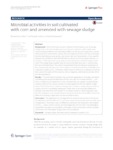Por favor, use este identificador para citar o enlazar este ítem:
http://www.alice.cnptia.embrapa.br/alice/handle/doc/1061757Registro completo de metadatos
| Campo DC | Valor | Lengua/Idioma |
|---|---|---|
| dc.contributor.author | VIEIRA, R. F. | pt_BR |
| dc.contributor.author | PAZIANOTTO, R. A. A. | pt_BR |
| dc.date.accessioned | 2017-01-25T11:11:11Z | pt_BR |
| dc.date.available | 2017-01-25T11:11:11Z | pt_BR |
| dc.date.created | 2017-01-25 | pt_BR |
| dc.date.issued | 2016 | pt_BR |
| dc.identifier.citation | SpringerPlus, Amsterdam, v. 5, n. 1, 16 p., 2016. Article 1844. | pt_BR |
| dc.identifier.uri | http://www.alice.cnptia.embrapa.br/alice/handle/doc/1061757 | pt_BR |
| dc.description | Background: One of the main concerns related to the increasing use of sewage sludge in the soil is the possible presence of excess nutrients, which could cause environmental problems and detrimental e?ects on the soil microorganisms, considered essential to soil nutrient cycling. Thus, the objective of this work was to evaluate the microbial biomass and activity and some chemical characteristics of one speci?c tropical soil, classi?ed as Dark Red Distroferric Latosol, of a loamy/clayey texture, in a long-term ?eld experiment using anaerobically digested household sludge amendment. The sludge doses applied were the recommended dose and 2, 4 and 8 times the recommended dose. The authors hypothesized that the frequent application of this compound to the soil, even when using the recommended dose, could a?ect the available phosphorus (Pav) and heavy metal contents of the soil, resulting in concentrations above the needs of the culture as well as negatively a?ecting the activity of the soil microorganisms. Results: The results demonstrated that successive applications of sludge, calculated considering the recommended dose of N for corn, did not increase the soil Pav contents in relation to the treatment in which the fertilizer was applied considering the nutrient needs of the culture, contrary to what happened with the highest sludge doses. The Cr, Ni and Cu contents increased with increase in sludge dose, but did not surpass the limits considered inadequate. There were no accentuated di?erences between the treatments with respect to microbial biomass C. Basal respiration and the FDA hydrolysis were considered to be the parameters that most di?erentiated the e?ect of increasing sludge doses on the microbial activity. Conclusion: The application of a sludge dose to a tropical soil, based on the recommended dose, did not a?ect the Pav or heavy metal contents of the soil even after years of application. Since there were no di?erences between the treatments with respect to the Cmic values, to the contrary of what happened with the other microbiological parameters evaluated, the possibility of changes in the composition of the microbial community with the higher sludge doses was considered. | pt_BR |
| dc.language.iso | eng | eng |
| dc.rights | openAccess | eng |
| dc.subject | Metabolic quotient | pt_BR |
| dc.title | Microbial activities in soil cultivated with corn and amended with sewage sludge. Microbial activities in soil cultivated with corn and amended with sewage sludge. | pt_BR |
| dc.type | Artigo de periódico | pt_BR |
| dc.date.updated | 2017-03-03T11:11:11Z | pt_BR |
| dc.subject.thesagro | Microbiologia do solo | pt_BR |
| dc.subject.thesagro | Adubo de esgoto | pt_BR |
| dc.subject.thesagro | Lodo residual | pt_BR |
| dc.subject.thesagro | Milho | pt_BR |
| dc.subject.thesagro | População microbiana | pt_BR |
| dc.subject.thesagro | Impacto ambiental | pt_BR |
| dc.subject.nalthesaurus | Sewage sludge | pt_BR |
| dc.subject.nalthesaurus | Microbial activity | pt_BR |
| dc.subject.nalthesaurus | Corn | pt_BR |
| dc.subject.nalthesaurus | Environmental impact | pt_BR |
| riaa.ainfo.id | 1061757 | pt_BR |
| riaa.ainfo.lastupdate | 2017-03-03 | pt_BR |
| dc.identifier.doi | http://dx.doi.org/10.1186/s40064-016-3502-9 | pt_BR |
| dc.contributor.institution | ROSANA FARIA VIEIRA, CNPMA; RICARDO ANTONIO ALMEIDA PAZIANOTTO, CNPMA. | pt_BR |
| Aparece en las colecciones: | Artigo em periódico indexado (CNPMA)  | |
Ficheros en este ítem:
| Fichero | Descripción | Tamaño | Formato | |
|---|---|---|---|---|
| 2016ap28.pdf | 1.03 MB | Adobe PDF |  Visualizar/Abrir | |
| microbialactivitiesinsoilcultivatedwithcorn.epub | 805.97 kB | Unknown | Visualizar/Abrir |









